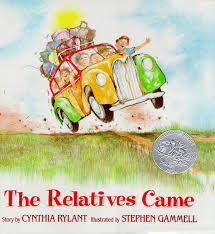It’s common knowledge that reading aloud daily to pre-school children is a vital step to help prepare them for success in school; in fact, the American Academy of Pediatrics endorses this habit. In line with the AAP, the 1000 Books Before Kindergarten initiative began several years ago, promoting the development of early childhood literacy through the shared and oh-so-pleasurable task of reading aloud to a child (with some helpful print and digital logs to track progress).
When you think about it, reading 1000 books to a child before kindergarten is actually a quantitative concept that’s not so hard to wrap one’s head around. That averages out to about 200 books per year between birth and the start of kindergarten--not even one a day! (And who can stop at just one?!) But how to begin selecting those 1000 books? To get started, the 1000 Books Foundation has compiled and posted on their website a very good list of 100+ titles called “Books Your Child Should Hear Before Kindergarten.” This list is a great roadmap for parents to take to their local library or retailer. Here are five of my personal favorites that I have especially loved reading aloud both to my own children and those I’ve served in public and school libraries.

Whose Mouse Are You? by Robert Kraus, pictures by Jose Aruego. This simply written paean to the centrality of family ties and love in a young (mouse) child’s life blends rhyming text and colorful, amusing illustrations seamlessly. Each page spread deftly anticipates the next with humor and heart. Just right for preschoolers.
Good Night, Gorilla by Peggy Rathmann. This nearly-wordless book relies on rib-tickling, predictable visual jokes to tell the story of a hapless zoo keeper whose attempts to keep his animal charges safely locked up at night are thwarted by a key-snatching gorilla. Very young children will catch right on to what is happening and relish the amusing details, again and again.
A Visitor for Bear by Bonny Becker, illustrated by Kady MacDonald Denton. A large curmudgeonly bear, who lives alone quite by choice in his forest house, is called on by a very small, polite mouse. Finally outdone by the mouse’s persistence in staying for a visit, the bear relents and lets Mouse stay for a “spot of tea” … and slowly realizes, through their conversation, the pleasures of companionship. The comic visual and verbal antics of both the mouse and bear combine perfectly with repetitive language and just enough plot to hold a young child’s attention.

The Relatives Came by Cynthia Rylant, illustrated by Stephen Gammell. The excitement of relatives coming to visit could not be more joyously rendered for a young child than in this book. Arising at dawn in Virginia and driving hundreds of miles over hill and dale in their overstuffed car, “the relatives” finally arrive at their destination, where their assorted kin sweep them exuberantly into their home and lives for a cozy, active and extended stay. Warm, conversational text matches perfectly with delightful, humorous drawings exquisitely rendered in colored pencil. A Caldecott Honor Book. Readers of all ages will be sorry when this family reunion comes to an end.

Mike Mulligan and His Steam Shovel by Virginia Lee Burton. When your preschooler is ready for a longer “listen”, there is no better book to read aloud than Burton’s beloved, enduring tale of a determined steam shovel named Mary Anne and “her” driver, Mike Mulligan. Brightly colored, whimsical crayon drawings evoke a small town community of an earlier era in which new-fangled gas and diesel-engine contraptions are threatening to put both Mary Anne and Mike out of business. The duo finds a creative way to repurpose themselves in a way that has left generations of readers and listeners cheering.
Dive into “1000 Books Before Kindergarten” with these sure-fire pleasers...you and your preschooler will love them!
Saint Francis Xavier School
Developing the whole person:
Academics, Faith, Community and Character
Interested in learning more about Saint Francis Xavier School? Just fill out our inquiry form and someone will be in touch!











